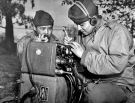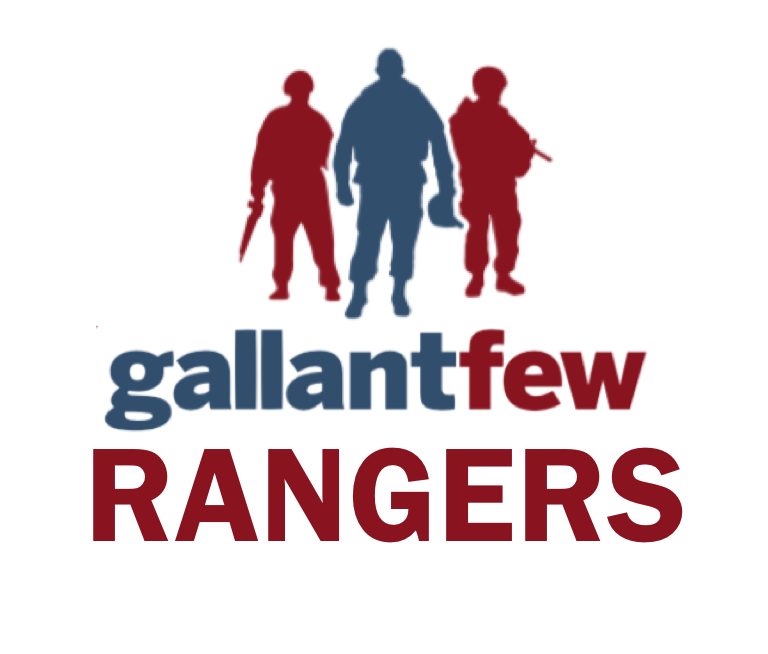In 1943, Horn volunteered for assignment with “Merrill’s Marauders,” a deep penetration unit under the command of Maj. Gen. Frank Merrill. During five months of field operations in Burma and western China, Merrill’s Marauders completed an 800-mile trek across the Himalaya Mountains on a mission to cut Japanese communications and supply lines ahead of a planned joint U.S./China attack.
 SSG Gilbert Horn Sr.
SSG Gilbert Horn Sr.from Fort Belknap Indian Reservation, Montana
SSG Horn served with:
Born in 1923, Ranger Horn was 92 years old at the time of his death in 2016.
Complete biography is below the photo gallery
SSG Gilbert Horn Sr.'s Biography
In 1943, Horn volunteered for assignment with “Merrill’s Marauders,” a deep penetration unit under the command of Maj. Gen. Frank Merrill. During five months of field operations in Burma and western China, Merrill’s Marauders completed an 800-mile trek across the Himalaya Mountains on a mission to cut Japanese communications and supply lines ahead of a planned joint U.S./China attack.
During his military service, SSG Gilbert Horn Sr. also served in 5307 Composite Unit (Provisional) Merrill's Maurauders
---
http://www.khou.com/mb/news/nation-now/decorated-wwii-code-talker-merrills-marauder-dies/109036669
GREAT FALLS, Mont. — Gilbert Horn Sr., a decorated World War II veteran honored for his service as a Native American code talker, died Sunday at the Northern Montana Care Center in Havre. He was 92.
Horn was born May 12, 1923, to Melvina and Jesse Iron Horn Sr., on the Fort Belknap Indian Reservation in Montana. At the age of 17, he enlisted in the U.S. Army and became a member of the 163rd Infantry Battalion. Horn received specialized training in communications and encryption, then volunteered for special duty as a code talker, using his native Assiniboine Tribe language skills to disguise U.S. military communications during the war against the Japanese.
In 1943, Horn volunteered for assignment with “Merrill’s Marauders,” a deep penetration unit under the command of Maj. Gen. Frank Merrill. During five months of field operations in Burma and western China, Merrill’s Marauders completed an 800-mile trek across the Himalaya Mountains on a mission to cut Japanese communications and supply lines ahead of a planned joint U.S./China attack.
Horn was one of fewer than 1,200 men who survived the campaign, and was wounded in the chest, back and jaw before finally being evacuated. He received both the Bronze Star and a Purple Heart, and was recognized along with all the members of Merrill’s Marauders by a Distinguished Unit Citation for “gallantry, determination and esprit de corps in accomplishing its mission under extremely difficult and hazardous conditions.”
Following his discharge from the U.S. Army, Horn returned to the Fort Belknap Indian Reservation. In addition to assuming duties on his grandparents’ farm, Horn served as a member on the Fort Belknap Community Council for 19 years, wrote the first regulations for the Fort Belknap Tribal Juvenile Court, lobbied in Washington, D.C., for a new tribal health clinic and served as chairman of the Rocky Mountain Region of the National Congress of American Indians.
In 2013, MSU-Northern awarded Horn an honorary doctorate in humanitarian services. One year later he was named honorary chief of the Fort Belknap Assiniboine Tribe, a title not previously awarded since the 1890s. A new early learning center on the Fort Belknap Reservation has been named in Horn’s honor.
Horn, aka Shunk Ta Oba Kni or Returns With A Prisoner Horse, is survived by 11 children, 37 grandchildren and nearly 90 great- and great-great-grandchildren. He will be interred at the family cemetery east of Fort Belknap Agency on Wednesday.
Follow David Murray on Twitter: @GFTrib_DMurray
http://www.stripes.com/news/veterans/native-american-who-served-as-code-talker-during-wwii-dies-at-92-1.401865
GREAT FALLS, Mont. — Gilbert Horn Sr., a Native American code talker who returned from World War II to spend decades serving the Fort Belknap Assiniboine Tribe as a judge and council member, has died of natural causes. He was 92.
Horn died Sunday at Northern Montana Care Center in Havre, Kirkwood Funeral Home said. His memorial service was scheduled Wednesday.
Horn was born on the Fort Belknap Indian Reservation in 1923. He joined the U.S. National Guard at age 15 as a way to escape the poverty of the reservation. He enlisted in the Army at 17 after the Japanese bombed Pearl Harbor.
Horn was initially trained as a sharpshooter and later received some training in communications and encryption and joined other Indians who used their native languages to send coded messages during World War II. The work of the code talkers remained classified until 1968.
Horn volunteered for service as a member of Merrill's Marauders, a special operations unit of 2,750 men whose mission was to cut Japanese communications and supply lines in the Burmese jungle, the Great Falls Tribune reported.
"It was a fighting unit, ready for action any time," Horn told the Tribune during an interview for a story published in January 2014. "I wanted to go see the war. I didn't want to be in Montana all my life. I wanted to see what's across that big waters called the oceans."
The unit made an 800-mile trek over the Himalaya Mountains into the jungle with only the weapons and supplies they could carry on the 720 mules and horses they brought with them. The Marauders fought through monsoon season. Troops suffered from malaria, dysentery and typhus. Horn was wounded four times.
"There was no support. We didn't have any artillery. They just kept on knocking us down, whittling us down," he said in 2014. "It is hard to believe what we had to go through."
Horn — one of 1,200 soldiers who survived the Marauders' campaign — was awarded a Purple Heart. Each soldier also received a Bronze Star.
Despite his military heroics, when Horn returned to the reservation in June 1945, he said he was "treated like dirt."
Veterans were supposed to be given preferential treatment when applying for certain jobs and qualify for low-interest federal housing loans, but he said that almost never happened.
He worked on his grandparents' farm and received schooling in business management, psychology and legal work.
Horn served on the Assiniboine Treaty Committee for 68 years. He was a member of the Fort Belknap Community Council for 19 years and was a tribal judge for eight years, during which time he wrote the first regulations for the tribe's juvenile court. He was a member of the health board that lobbied for a new clinic and also helped get the Head Start program established on the reservation. One of its buildings was named after Horn, whose Indian name is "Shunk Ta Oba Kni," or "Returns With Prisoner Horse."
In 2013, he received an honorary doctorate in humanitarian services from Montana State University-Northern. In May 2014, he was named the chief of the Fort Belknap Assiniboine Tribe, the first tribal chief in more than 125 years.
Horn is survived by 10 of his 11 children, 37 grandchildren, 71 great-grandchildren and 18 great-great-grandchildren.
http://www.greatfallstribune.com/story/news/local/2016/03/30/goodbye-gil/82453100/
In death as in life, the honor and respect bestowed upon Gilbert Horn Sr. transcends cultures and generations.
The decorated World War II combat veteran and Assiniboine tribal leader was laid to rest Wednesday, his earthly remains interred within a plot at the Horn family cemetery overlooking the Milk River.
Horn died Sunday at the age of 92.
===
GREAT FALLS TRIBUNE
To the broader outside world, Horn was best known as a Native American code talker who fought with the storied WWII deep penetration unit known as Merrill’s Marauders. But to those who knew him best, he was simply “Uncle Gil,” chief of the Fort Belknap Assiniboine Tribe.
“My dad touched a lot of people’s lives in a good way,” said Willowa “Sis” Horn, Gilbert Horn’s oldest daughter. “But to me he was just daddy – just my dad.”
Horn was born May 12, 1923, during an era when much of white society viewed Native culture as a quaint anachronism – something that would be gradually extinguished as Indian people were assimilated into the dominant western culture.
“The language which they forbade me to speak is the language that saved this country,” Horn would say on occasion, reflecting back on his grade school education, as well as the important role he played as a code talker during the Second World War.
After enlisting in the National Guard in 1940, Horn was quickly transferred to the regular Army, then thrust into some of the most violent battles in the Pacific. He fought as a rifleman and used his native Assiniboine language to transmit encrypted radio messages for the Army during the battle for Guadalcanal and in campaigns from New Guinea to the Solomon Islands.
===
GREAT FALLS TRIBUNE
Tales of a Code Talker: Assiniboine man used Native language, rifle skills to help U.S. in World War II
In the fall of 1943, Horn volunteered for an elite deep penetration unit fighting behind Japanese lines in Burma. During five months of field operations, Horn and the 2,750 men of Merrill’s Marauders completed an 800-mile trek across the Himalaya Mountains and engaged the enemy in five major battles and dozens of smaller skirmishes.
Horn was wounded four times, including rounds to the chest, back and jaw. For his service he was awarded both a Purple Heart and a bronze star. His entire unit was recognized for “gallantry, determination, and esprit de corps in accomplishing its mission under extremely difficult and hazardous conditions.”
However, it is for his life and accomplishments after the war that Horn is most fondly remembered on the Fort Belknap Indian Reservation.
He returned to Montana a war hero and at first believed the racism he’d known as a child would be erased.
“After World War II, they thought things would be changed,” longtime family friend Jessie James said of the Native American veterans’ experience, “that there would be more opportunities – but there weren’t.”
If the experience embittered Horn, he never showed it. In the jungles of Burma and Guadalcanal there were no Indian and white soldiers. They were brothers in arms, warriors together, and the memory of that shared camaraderie tempered the feelings of disappointment Horn felt upon finding so little had changed back home in Montana.
“The war was very profound in his life because it made all the Indian soldiers equals with the non-Indians,” Horn’s granddaughter Liz Doney said of her grandfather’s perspective. “He befriended them and became their comrade. He was kind of a bridge between the cultures.”
For many years, Horn would host an annual feed for all the area veterans. The event always took place in May, near the occasion of his own birthday. It was Horn’s present to the memory of the men he’d served with.
Following the war, Horn threw his energies into work on his family’s ranch. Beginning in the 1950s, he began to assume a greater leadership role within the Assiniboine Tribe.
Horn served as councilman on the Fort Belknap Community Council for 19 years and as a tribal court judge for eight years. It was during his term on the bench that Fort Belknap’s first tribal juvenile court regulations were written.
Though Horn only finished the eighth grade himself, throughout his life he was always a strong advocate for education.
“One of the things he stressed to all of us was the value of education, and he did a lot for the schools,” Sis Horn said.
During his life in public office, Horn served for six years on the National Indian Head Start Board and was instrumental in having the preschool education program established on the Fort Belknap Reservation. One of that institution’s buildings is now named for him: The Gilbert Horn Sr. Early Head Start Center.
Gilbert Horn’s greatest pride, however, was reserved for his family. He raised 11 children during his lifetime, and to his dying day, Horn rejoiced at the opportunity to play with his many grandchildren.
===
GREAT FALLS TRIBUNE
Vietnam veterans told ‘Welcome home’
“Even when he was really sick, he managed to reach out and touch them and tease them,” Sis Horn said. “He sure loved little kids.”
Today the Horn family counts 37 grandchildren, 71 great-grandchildren and 18 great-great-grandchildren who descended from their honored grandfather.
As he neared the end of his life, the weight of all Horn had accomplished gradually percolated to the surface. In May 2014, Montana State University-Northern presented Horn with an honorary doctoral degree in humanitarian services. To this day, Horn remains only the second person in the university’s 87 year history to ever receive such an honor.
In that same month, Horn was named chief of the Fort Belknap Assiniboine Tribe, the first chief the tribe had recognized since the 1890s.
“He wanted us all to have his story in our hearts and to preserve his traditional ways,” Liz Doney said of her grandfather’s legacy. “He wanted us all to carry that through to the next generation.”
Toward the end of a wake held in Gilbert Horn’s honor, 23 women from the Horn family lined up to participate in a traditional Assiniboine ceremony to acknowledge the grief at their grandfather’s passing. One by one, each had their long hair cut away, marking them for a yearlong period of mourning.
Their shorn locks were then tenderly laid beside Gilbert Horn in his casket, a tribute to accompany him on his journey to the afterlife.
http://www.whitewolfpack.com/2016/04/native-american-wwii-hero-gilbert-horn.html














